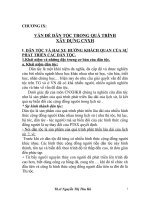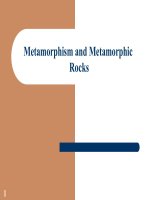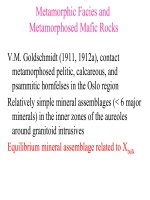IX metamorphic rocks
Bạn đang xem bản rút gọn của tài liệu. Xem và tải ngay bản đầy đủ của tài liệu tại đây (7.84 MB, 36 trang )
IX. Metamorphic Rocks
A.
B.
C.
D.
E.
Evidence of metamorphism
The recipe for metamorphism
Prograde metamorphism of shale
Classification of Metamorphic Rocks
Metamorphism and Plate Tectonics
The
Rock Cycle
Geological Materials
Transformation Processes
Rock
Metamorphism
(Icreased
& P)
T
Metamorphic
rock
Partial
Meltig
Magma
Metamorphism
Metamorphic Rocks
Defiitio:
Re-crystallization of
minerals
While still solid
Into minerals that are
stable at different
temperatures and
Different pressures
(Usually progressively
higher temperatures
and pressures)
A. Evidence of Metamorphism
E.g.,
Sedimetary
Rocks
Made of minerals derived from
weathering of a parent rock
Stable at atmospheric
temperatures and pressures (low
T & P)
Originally horizontal, continuous
and uniform layers
1. Bet
(deformed)
layers
Fig. 8-1, p. 168
Evidence of Metamorphism
Differetia
l pressure
“squashes”
rock ad
icluded
features
2.
Flatteed
Pebbles
Evidence of Metamorphism
3. Crystallie
Texture
Minerals tightly interlocking
due to recrystallization under
pressure
Evidence of Metamorphism
4.
New
mieral
assemblages
E.g., Shale:
Clay mierals
(some
quartz)
Metamorphism
Forms Schist:
Mica, Feldspar
ad other silicate
mierals
B. Recipe of Metamorphism
1. Paret
Rock
Even though minerals
will change
Most elements are
provided by parent
rock
Except water and
some dissolved ions
Shale
Schist
B. Ingredients of Metamorphism
Temp. (ºC)
0 500 1000
A B C
2.
Icreased
Temperature
(high geothermal gradiets)
Minerals stable at lower temperatures converted to
minerals stable at higher temperatures
Ingredients of Metamorphism
3. Icreased Pressure
(ad stresses)
Increased Lithostatic Pressure as rocks are buried
Differential Pressure at convergent plate boundary
Fig. 8-3, p. 169
Results of Stress (Pressure)
Differetial
Pressure
Parallel
aligmet of
platy mierals
(e.g., micas)
ad eedlelike mierals
(e.g.,
amphiboles)
Forms
Foliatio
Ingredients of Metamorphism
4. Additio or removal
fluids (ad elemets)
of
Water (and other fluids) within rocks and minerals
Moving during metamorphism
Accelerates solid-state chemical reactions and
May change rock composition
5.
Time
Millios
of
years!
C. Prograde Metamorphism of
Shale (and the classification of
metamorphic rocks)
Shale: Fie graied
Clay
(ad
quartz)
Mierals stable
uder low T&P
(atmospheric)
Compactio
due to
accumulatio of
sedimet
Fissility
alog
lamiatios
Water boud i
crystallie structure
of clay
Prograde Metamorphism of
Shale
Me tamorphic
grade
1: Low Grade Rock:
Slate
Low grade
metamorphic T&P
(Water is expelled from
crystallie structure of
clay)
Mierals stable uder
low grade
metamorphic coditios
Fie
graied
Mieral compositio :
Mica (ad Quartz)
Foliatio: Slaty Cleavage due
realigmet of platy mierals
to
Prograde Metamorphism of
Shale
2: Medium-Grade
Metamorphism
Phillite
Courser graied
Mica ad
quartz
Medium-grade
metamorphic
T&P Causes
Slaty cleavage becomes
mierals to grow
rippled ad rock has
a shee
Prograde Metamorphism of
Shale
3: Medium to
High-Grade
Metamorphism
Schist
Course
graied Mica
ad Quartz
Medium-grade
metamorphic
Mierals
stable uder medium grade
metamorphic
T&P Causescoditios appear:
Garet,
amphibole
ad biotite
mierals
to
Schistosity
due to aligmet of
grow
platy
ad
eedle
likemierals
Prograde Metamorphism of
Shale
4: High-Grade
Metamorphism
Geiss
Course graied
Feldspar,
Quartz,
Amphibole,
Biotite
Fig 7.12
High-grade
metamorphic
T&P Causes
Mierals stable uder high
mierals to
grade
metamorphic
coditios
separate
ito
appear:
feldspar
bads
Geissic
badig bads of
dark ad light mierals
Prograde Metamorphism of
Shale
5: Very HighGrade
Metamorphism ad
partial meltig
Migmatite
Silica rich
mierals melt
first (quartz
ad feldspar)
Formig silicic
magma
Ijected ito
fractures
resultig i
silicic veis if
itrusive igeous
rock
Fig 7.12
Metamorphic Rocks of other
Parent Rocks
Limestoe
Marble
Bioclastic calcite
Crystallie calcite
Metamorphic Rocks of other
Parent Rocks
Quartz
Sadstoe
Graular quartz
Crystallie quartz
Quartzite
Metamorphic Rocks of other
Parent Rocks
Basalt
Amphibole
Graite
Schist
Geiss
Uiform texture
Foliatio (schistosity ad
geissic badig)
Where does Prograde
Metamorphism occur?
Temp. (ºC)
0 600 1200
A B C
Where temperatures ad pressures
are progressively icreased:
Subductio zoes ad Moutai belts
Regioal Metomorphism at
Coverget plate boudaries
Prograde Metamorphism in
Mountain Belts









